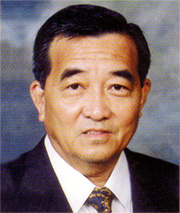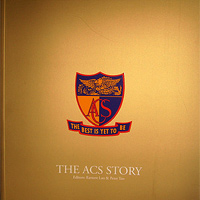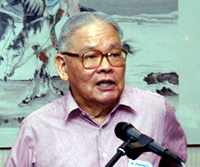The veritable treasure chest of a
book entitled The ACS Story first wowed the Anglo-Chinese School
family in 2003. It contained so much information, much of it well
known, a lot of it true revelations, that — five years on — some of
us may still be delving into it to savour more fully the jewels of
our alma mater’s origins and the ACSian soul.
Then the irrepressible Chairman
of the ACS Board of Governors asked for an update of the book. So
work on the second edition got underway. The book is now a soft
cover, though, not hardback like its predecessor. But, with 408
pages, it has 58 more sheets. It rolled off the presses towards the
end of 2007.
The ST report said: "Nine
obtained the perfect score of 45, making up almost half of only
20 candidates worldwide with that score. About 5,500 took the
examinations around the world last November. ACS (Independent)
is the first Singapore school to offer IB (the International
Baccalaureate) in place of the A-levels."
 Even our Governors’ Chairman
Tan Wah Thong could not have
foreseen that level of accomplishment! But he had felt that it
was time for an update of the ACS story. As he says in the
Foreword of the new edition: "There have been many changes and
additions to the ACS Landscape since the publication of the
first edition … Two private schools, ACS (International)
Singapore and ACS (International) Jakarta, have been established
… The total student population of the ACS schools has increased
from 7,500 to more than 10,000..."
Even our Governors’ Chairman
Tan Wah Thong could not have
foreseen that level of accomplishment! But he had felt that it
was time for an update of the ACS story. As he says in the
Foreword of the new edition: "There have been many changes and
additions to the ACS Landscape since the publication of the
first edition … Two private schools, ACS (International)
Singapore and ACS (International) Jakarta, have been established
… The total student population of the ACS schools has increased
from 7,500 to more than 10,000..."
Now, isn’t that sheer
serendipity, the timing of the book’s second edition and that of
the pioneering IB achievements?
Happy happenstances have been
coming our way even before the founding of the first
Anglo-Chinese School in 1886.
Twenty-eight years earlier, a 22-year-old teacher in America saw
a Methodist Church advertisement for "six young men urgently needed in
India", The ACS Story reveals. Thus James M Thoburn, who was
to become the First Bishop of the Methodist Church in Singapore
in 1888, went as a missionary to India. He built up a reputation
as perhaps the best known evangelist in that country. When his
renown reached Singapore, he was invited "to expand Methodist
work further East". That he did.
The next happy happenstance
of note took place in Poona, India. Another young teacher
working for the church, William F Oldham, went into an
evangelistic meeting and came out wanting to become a
missionary. After completing his training in America, he was
re-assigned to Singapore instead of Bangalore. That change came
about after a church elder — maybe uncharacteristically — gave
his superior an ultimatum: "Bishop, if you do not appoint W F
Oldham and wife to Singapore, I don’t want to have anything to
do with the case. And so ACS’ founder came to us!
 Such gems enrich the book in
terms of content and decorate it in the literary sense. The
sense of history that they so engagingly instill in the
empathetic reader is the book’s true worth. The ACS Story takes
us through the ACSian family’s triumphs and tensions that were
and are very much a significant part of the social and political
development of Singapore.
Such gems enrich the book in
terms of content and decorate it in the literary sense. The
sense of history that they so engagingly instill in the
empathetic reader is the book’s true worth. The ACS Story takes
us through the ACSian family’s triumphs and tensions that were
and are very much a significant part of the social and political
development of Singapore.
In some respects, including
its physical size, the book is a weighty tome. It is meant to be
a serious history of the ACS family of seven schools and a
passionately loyal and supportive Old Boys’ Association. But it
is not all heavy going. It is a book well worth spending time
with. Take it not in one sitting as at a banquet, but savour the
nourishing dishes and piquant delicacies as at a conveyor-belt
buffet, choosing what you want to partake, taking your time,
leaving it and coming back to it as and when. Feel free to taste
the best dishes more than once. As you chew on the words, imbibe
the moods and moments captured in photographs old and new. You
will not feel overfed, I assure you.
The original editor
Ernest Lau (who needs no
introduction among ACSians) was joined by co-editor
Peter Teo (who edits
Methodist Message) in refining text, broadening research and
writing fresh passages. Editor Lau says of his latest
undertaking: "… it has not been easy to put together a coherent
account, nor has it been possible to deal with all the issues
which the School faced in its history”. Thus the “snobbery”
issue of the not-too-distant past that gave ACS much unwanted
infamy gets only passing mentions. A pity, I think, for that
episode was a traumatic test of the ACS character. Did we pass
the test?"
 Editor Lau says that
"it will
be for future historians to amend, expand and improve” the book.
I am no historian. I just know that more than a few teacher
friends, including those from so-called rival schools, have no
hesitation in noting the confidence, the social graces and a
certain charm among ACS boys. Among ACS girls, too, I hope."
Editor Lau says that
"it will
be for future historians to amend, expand and improve” the book.
I am no historian. I just know that more than a few teacher
friends, including those from so-called rival schools, have no
hesitation in noting the confidence, the social graces and a
certain charm among ACS boys. Among ACS girls, too, I hope."
"There was no ‘master plan’,”
Editor Lau says, “unless giving an education to as many who
could benefit from it qualifies as one, and the School developed
as a private Christian institution in response to the
educational requirements of Singapore society … ACS is the fruit
of the labour of missionaries, teachers, administrators and Old
Boys, whose story is marvelous to record."
So, you see, we have been
blessed with serendipity, but we have also tried our best. Our
motto remains The Best Is Yet To Be.
But ACS and ACSians have achieved much of the best. That is the
continuing ACS story, folks!